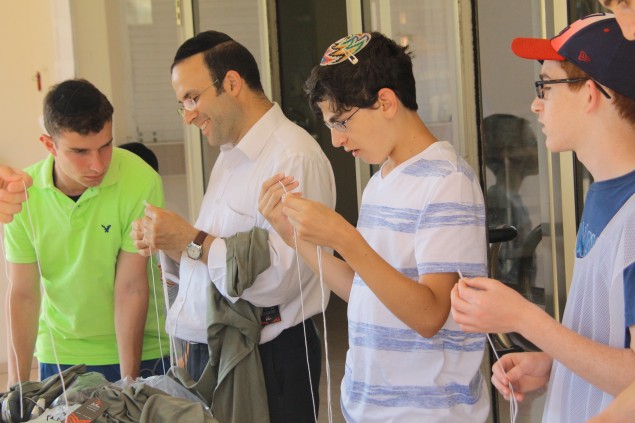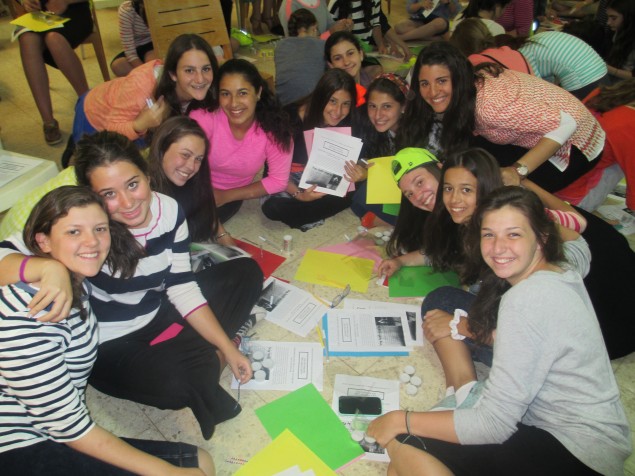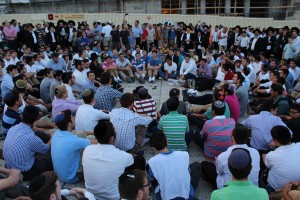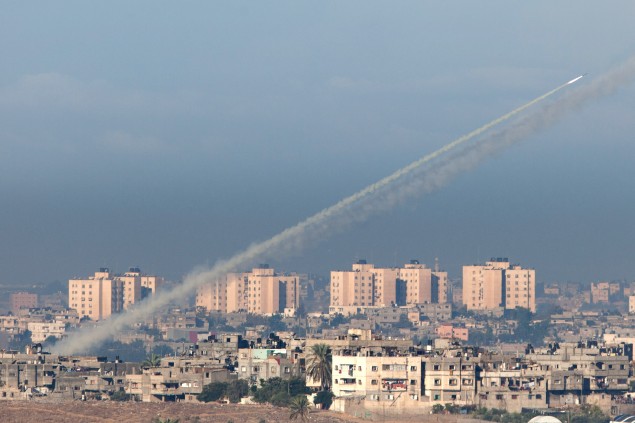NCSY Summer 2014: Not Your Typical Summer Experience
While Diaspora Jews spent this past summer glued to news from Israel, the nearly 600 teens and staff on NCSY Israel summer programs not only witnessed Israel’s fight for survival up close, they joined the war effort—raising the spirits of Israeli soldiers, citizens and one another, making summer 2014 one that will be imbedded in their hearts for life.
The rocket attacks in Israel, their rapid escalation and the far-reaching targets took everyone—including NCSY staff—by surprise.
Rivka Yudin was at home in Ramat Beit Shemesh when she heard the dreaded wailing of the warning siren. She and her husband grabbed their kids and ran for the miklat (bomb shelter). Rivka made sure to take her cell phone. As director of Michlelet, NCSY’s girls’ summer program that combines chesed, Torah learning and trips across Israel, she had to let David Cutler, director of NCSY summer programs and finances, know that the Michlelet Beit Shemesh campus had just become vulnerable to attack.
She texted: siren just went off here in Ramat Beit Shemesh . . . in the miklat . . .
At that moment, a plane full of excited Michlelet participants was approaching Tel Aviv. Decisions had to be made, the itinerary changed.
In the interest of safety, NCSY sent the 105 girls straight up north, to a hotel in Chispin in the Golan. NCSY Kollel, a learning program for boys based in Beit Meir, near Jerusalem, soon followed.
Cutler, who oversees all twelve NCSY summer programs, eight of which were in Israel when the war broke out, spent this past summer with his ear attached to the phone and his eyes fixed on the computer. Talking, texting, e-mailing and updating, Cutler spent countless hours rearranging participants’ accommodations and daily schedules with NCSY’s tour provider. Taking brief breaks to shower, dress and pray, he was also busy communicating with summer program directors and concerned parents via e-mail.
Due to the war, two of the ten programs that spend time in Israel each summer did not go to Israel this year. The Jerusalem Journey (TJJ), an Israel trip geared for public school kids, relocated to the West Coast and Euro ICE, a tour of Europe and Israel, remained in Europe, cancelling its visit to the Holy Land.
Despite the precariousness of the situation, NCSY parents had complete faith that their teens were safe and having “the best summer ever.” And even though schedules had to be changed—at times on a daily basis—NCSY staff strove to provide a sense of comfort and normalcy.
“Neither [my husband nor I] had the notion not to let them go,” says Shoshana Schechter of New Hempstead, New York, mother of Yoni, who attended NCSY Kollel this past summer, and Ayelet, who attended Michlelet.
Lisa Berman of Toronto, whose daughter Leah attended Michlelet, concurs. “I was so impressed with everything that the OU and NCSY did to ensure the kids were safe; they were in close communication with the Cheder Matzav [the situation room] in Israel. If I had a question, and I did, [NCSY] e-mailed me back straight away. We knew [Leah] was in good hands.”

NCSY Kollel students made army-authorized camouflage green tzitzit, which were then distributed to those on the front lines immediately upon their completion.
Relocated to Chispin, a yishuv in the heart of the Golan, NCSY Kollel flourished in its new location, which accommodated its group of more than 250 and included an air-conditioned beit midrash, spacious dining room and sports facilities. Despite the geographic disruption, the learning and chesed components of the programs continued—albeit with some differences.
Much of the Kollel’s rabbinic staff, as well as the Michlelet lecturers, based in the middle of the country, couldn’t manage the three-and-a-half-hour commute to Chispin on a daily basis (many of them did make the trip twice, leaving their families from early in the morning until late at night). Local teachers as well as rebbeim from the States, who came for the summer to teach at the Kollel and relocated with the group along with their families, promptly stepped up to the plate to fill in the gaps.
Michlelet, which usually books lecturers months in advance, managed to procure an array of dynamic speakers, some from the local area and others who were willing to make the long drive from the center of the country. “Every day a different speaker worked out,” says Yudin.
“We were blessed with siyata d’Shmaya to be able to sustain the program in such a way,” says Rabbi Moshe Benovitz, director of NCSY Kollel for more than a decade.
The Divine help kept flowing, no doubt due to the teens’ nonstop efforts to help their beleaguered Israeli brethren.
“We felt very much a part of what was going on,” says Rabbi Benovitz. “Our learning and davening were focused throughout the summer on the soldiers in Gaza. We felt a huge sense of responsibility knowing we were the recipients of their bravery and self-sacrifice.” Rabbi Hershel Schachter, a rosh yeshivah at Yeshiva University and posek for OU Kosher who spends the summer teaching at NCSY Kollel, urged the boys not to underestimate the impact of their tefillot and hasmadah. “The Gemara says that the soldiers are successful in battle in the zechut of those who sit and learn.”
“It was late Thursday night when we heard that they were starting a ground war,” says Rabbi Zvi Sobolofsky, a rosh yeshivah at YU and rebbe at NCSY Kollel. “There was the feeling that the only place where we should be at that point was back in the beit midrash, back to our learning, our davening . . . . This was not your typical summer,” says Rabbi Sobolofsky.
The Kollel also took part in a “hands-on” chesed. One of the rebbeim’s brothers-in-law is involved in delivering tzitzit to soldiers in wartime. Kollel students jumped at the chance to join in. “We had a full beit midrash of boys sitting and making tzitzit,” says Rabbi Benovitz. The army-authorized camouflage green garments were distributed to those on the front lines immediately upon their completion.
Students at Michlelet contributed to the war effort as well by arranging a carnival for children whose fathers were called away on miluim (army reserve duty), giving the mothers much-needed respite. They also created beautifully decorated care packages for soldiers with items such as soap, shampoo, socks, candy and chocolates; each package featured a letter with words of chizuk and gratitude, which the girls personally delivered to the soldiers.

Michlelet participants prepared packages with tea lights, the berachah for hadlakat neirot and the tefillah for chayalim. They then distributed the packages in malls and shopping centers, encouraging women to light Shabbat candles in the zechut of the chayalim.
“The chayalim couldn’t get over the fact that American girls came to Israel during wartime when they could have easily stayed at home, and that they were so happy to be there,” says Schechter.
Yearning for Yerushalayim
JOLT (Jewish Overseas Leadership Training program), NCSY’s five-week tour designed to introduce young men and women to their Jewish past, present and future, usually starts out in Europe—more specifically, Poland, Germany and Austria. The group learns of the once-thriving Jewish communities, they visit death camps and, on the final leg of their journey, they fly to Israel. This summer, the participants faced the possibility of not making it to the crucial crescendo of the trip.
“When they canceled all flights to Israel, the kids were extremely distraught,” says Rabbi Eli Zians, director of JOLT. Participants on NCSY’s Anne Samson Jerusalem Journey Ambassadors Poland (TJJ AP), a leadership program for public school teens, shared their trepidation. “The entire time we were in Poland we didn’t know if we were going to be able to go to Israel,” says Marc Fein, director of TJJ Ambassadors Poland. “David Cutler sent us frequent updates on the security situation. The kids would ask on a daily basis if we were going to Israel. After we left Auschwitz/Birkenau, I read to our group the e-mail that David had sent, allowing us to go to Israel. The kids on the bus exploded in singing.”
JOLT participants happened to arrive in Israel in the middle of a ceasefire; they went straight to the Kotel. It was erev Tishah B’Av. “There were a few participants who had never been to Israel before,” says Rabbi Zians. “We had them close their eyes and escorted them to the Kotel, telling them about what Yerushalayim represents, and how the entire Jewish nation used to come three times a year. We didn’t take being there for granted; we appreciated every single moment. Every moment was a gift.”
“It was like 1967 all over again,” says Erin Stiebel, director of Girls Israel Volunteer Experience (GIVE), an NCSY summer program that was relocated to Israel’s north for three weeks. “When we made the announcement that we were able to visit Yerushalayim, there was an explosion of cheers, singing and dancing. It was incredible.”
The GIVE program primarily focuses on volunteer work and has teens helping Israelis in need, visiting soup kitchens and nursing homes and painting kindergartens in underprivileged communities. Although GIVE had to scratch its initial itinerary due to the war, participants on GIVE gave nonetheless.
The group ran tie-dye and jewelry making projects for families who moved to the north after evacuating their homes in Israel’s south. “Just being there showed our support for the country,” says Stiebel. “People asked us, ‘Your program isn’t going back to America? You are actually staying here?’ In good times and bad, we’re a nation.
“The girls were all so positive all summer,” she says. “They were willing to work with us, to be flexible with the changes. It was definitely not what they had signed up for. It wasn’t the mainstream GIVE summer experience, but it was way more special. It was a life-changing summer. We realized what it means to not have Israel as we know it, and to yearn for it.”
The parents agree. “They were connecting to Eretz Yisrael, Torat Yisrael and Am Yisrael in a deeper way than they would have had they gone on the program at another time,” says Schechter.

NCSY Summer 2014 culminated with many of the programs gathering at the Kotel for the NCSY signature post-Tishah B’Av kumzitz.
“Israel is not just a place where you go for fun and vacation,” says her husband, Yitzchak, a clinical psychologist who attended NCSY Kollel himself as a teen. “Chazal teach us that we have to also participate in the sorrow of the Jewish people.”
The Schechter children acquired first-hand knowledge of the kind of life balance one has to maintain when surrounded by violent enemies, say their parents. “They’re banana boating on the Kineret, saying Tehillim, going to waterparks and making shivah calls,” says Shechter. “They’re also creating stronger bonds with each other because of the difficult situation.”
And, they’re growing. “It was an eye-opening, maturing experience,” says Berman. “Leah now looks at life differently, with a [heightened] sensitivity to others. The little things are just not important when you see how Israelis have to live.”
David Hoffman of Staten Island, New York, whose two sons spent the summer at NCSY Kollel, also noticed some changes. “I don’t have to wake them up for minyan. I used to have to remind them that it’s time to go for Minchah or Maariv; now, they say, ‘We know already.’”
“This summer differed qualitatively than summers past,” agrees Rabbi Benovitz.
NCSY Summer 2014 culminated with many of the programs gathering at the Kotel for the NCSY signature post-Tishah B’Av kumzitz. “The kumzitz took on new meaning this year,” says Cutler, who came for the final three weeks of the programs. “It was one of the most moving moments I have ever experienced. I witnessed the growth, bonding and inspiration that had taken place over the summer. The feeling that this is our home and we belong here was more evident than ever before.”
Bayla Sheva Brenner is senior writer in the OU Communications and Marketing Department.

